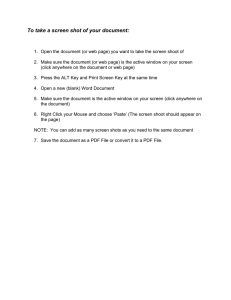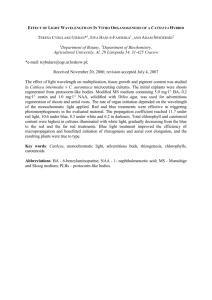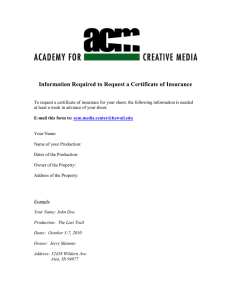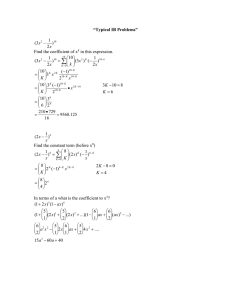High frequency in vitro shoot regeneration of Capparis deciduas from shoot tip culture
advertisement
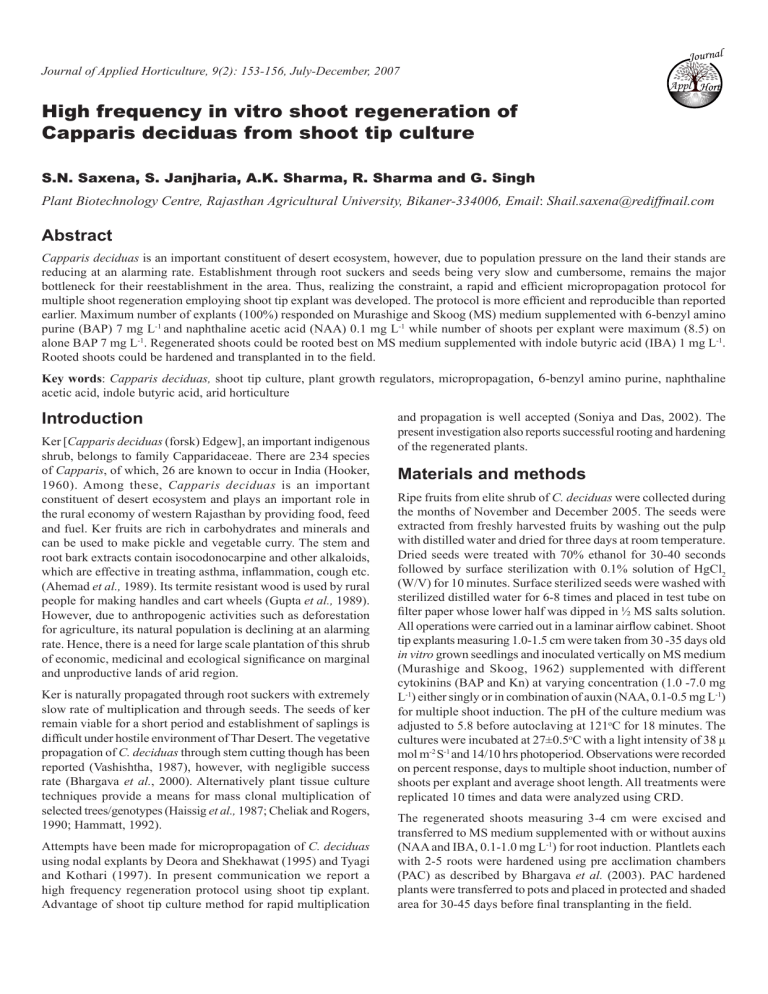
Journal Journal of Applied Horticulture, 9(2): 153-156, July-December, 2007 Appl High frequency in vitro shoot regeneration of Capparis deciduas from shoot tip culture S.N. Saxena, S. Janjharia, A.K. Sharma, R. Sharma and G. Singh Plant Biotechnology Centre, Rajasthan Agricultural University, Bikaner-334006, Email: Shail.saxena@rediffmail.com Abstract Capparis deciduas is an important constituent of desert ecosystem, however, due to population pressure on the land their stands are reducing at an alarming rate. Establishment through root suckers and seeds being very slow and cumbersome, remains the major bottleneck for their reestablishment in the area. Thus, realizing the constraint, a rapid and efficient micropropagation protocol for multiple shoot regeneration employing shoot tip explant was developed. The protocol is more efficient and reproducible than reported earlier. Maximum number of explants (100%) responded on Murashige and Skoog (MS) medium supplemented with 6-benzyl amino purine (BAP) 7 mg L-1 and naphthaline acetic acid (NAA) 0.1 mg L-1 while number of shoots per explant were maximum (8.5) on alone BAP 7 mg L-1. Regenerated shoots could be rooted best on MS medium supplemented with indole butyric acid (IBA) 1 mg L-1. Rooted shoots could be hardened and transplanted in to the field. Key words: Capparis deciduas, shoot tip culture, plant growth regulators, micropropagation, 6-benzyl amino purine, naphthaline acetic acid, indole butyric acid, arid horticulture Introduction Ker [Capparis deciduas (forsk) Edgew], an important indigenous shrub, belongs to family Capparidaceae. There are 234 species of Capparis, of which, 26 are known to occur in India (Hooker, 1960). Among these, Capparis deciduas is an important constituent of desert ecosystem and plays an important role in the rural economy of western Rajasthan by providing food, feed and fuel. Ker fruits are rich in carbohydrates and minerals and can be used to make pickle and vegetable curry. The stem and root bark extracts contain isocodonocarpine and other alkaloids, which are effective in treating asthma, inflammation, cough etc. (Ahemad et al., 1989). Its termite resistant wood is used by rural people for making handles and cart wheels (Gupta et al., 1989). However, due to anthropogenic activities such as deforestation for agriculture, its natural population is declining at an alarming rate. Hence, there is a need for large scale plantation of this shrub of economic, medicinal and ecological significance on marginal and unproductive lands of arid region. Ker is naturally propagated through root suckers with extremely slow rate of multiplication and through seeds. The seeds of ker remain viable for a short period and establishment of saplings is difficult under hostile environment of Thar Desert. The vegetative propagation of C. deciduas through stem cutting though has been reported (Vashishtha, 1987), however, with negligible success rate (Bhargava et al., 2000). Alternatively plant tissue culture techniques provide a means for mass clonal multiplication of selected trees/genotypes (Haissig et al., 1987; Cheliak and Rogers, 1990; Hammatt, 1992). Attempts have been made for micropropagation of C. deciduas using nodal explants by Deora and Shekhawat (1995) and Tyagi and Kothari (1997). In present communication we report a high frequency regeneration protocol using shoot tip explant. Advantage of shoot tip culture method for rapid multiplication and propagation is well accepted (Soniya and Das, 2002). The present investigation also reports successful rooting and hardening of the regenerated plants. Materials and methods Ripe fruits from elite shrub of C. deciduas were collected during the months of November and December 2005. The seeds were extracted from freshly harvested fruits by washing out the pulp with distilled water and dried for three days at room temperature. Dried seeds were treated with 70% ethanol for 30-40 seconds followed by surface sterilization with 0.1% solution of HgCl2 (W/V) for 10 minutes. Surface sterilized seeds were washed with sterilized distilled water for 6-8 times and placed in test tube on filter paper whose lower half was dipped in ½ MS salts solution. All operations were carried out in a laminar airflow cabinet. Shoot tip explants measuring 1.0-1.5 cm were taken from 30 -35 days old in vitro grown seedlings and inoculated vertically on MS medium (Murashige and Skoog, 1962) supplemented with different cytokinins (BAP and Kn) at varying concentration (1.0 -7.0 mg L-1) either singly or in combination of auxin (NAA, 0.1-0.5 mg L-1) for multiple shoot induction. The pH of the culture medium was adjusted to 5.8 before autoclaving at 121oC for 18 minutes. The cultures were incubated at 27±0.5oC with a light intensity of 38 μ mol m-2 S-1 and 14/10 hrs photoperiod. Observations were recorded on percent response, days to multiple shoot induction, number of shoots per explant and average shoot length. All treatments were replicated 10 times and data were analyzed using CRD. The regenerated shoots measuring 3-4 cm were excised and transferred to MS medium supplemented with or without auxins (NAA and IBA, 0.1-1.0 mg L-1) for root induction. Plantlets each with 2-5 roots were hardened using pre acclimation chambers (PAC) as described by Bhargava et al. (2003). PAC hardened plants were transferred to pots and placed in protected and shaded area for 30-45 days before final transplanting in the field. 154 High frequency in vitro shoot regeneration of Capparis deciduas from shoot tip culture Results and discussion The shoot tip explants cultured on hormone free medium remained green but failed to produce shoots even after 3 weeks of incubation. Incorporation of cytokinins both BAP and Kn stimulated multiple shoot induction within 2 weeks of incubation thus indicating that shoot induction is a function of cytokinins activity. Time taken in multiple shoot induction (11.10 and 11.80 days) was less on lower levels of cytokinins (1mg L-1). Percent explants responding were more (86%) on higher levels of cytokinins (7 mg L-1, Table 1). The cultured explants showed their response by increase in length and formation of callus at basal cut end of the shoot tips. Later from this callus clump, new shoot buds were induced within 4-5 weeks of incubation. Number of shoots per explant was significantly more (8.50 and 6.00) on higher levels of cytokinins i.e. 7 mg L-1 either BAP or Kn, respectively (Fig. 1A) as compared to lower levels of Kn (1 and 3 mg L-1) in the medium (2-4 shoots per explant, Table 1). A concomitant decline in shoot length was observed as the concentration of cytokinins increased in the medium. Moreover, increased levels of cytokinins in the medium resulted in excessive cell division, and produced a clump of shoot. Those shoots having normal mode of regeneration developed into healthy plantlets. Similar observations in various tree species are also recorded by Ahuja et al. (2002) and Pattnaik Table 1. Effect of plant growth regulators on shoot regeneration from shoot tip explant of Capparis deciduas Treatment (mg L-1) Response (%) MS plain + BAP 0.00 Average Number Time taken in length of of shoots multiple shoot induction (MSI) per explant shoots (cm) (30 DAI) (30 DAI) 0.00 0.00 0.00 1 3 5 7 66.60 80.00 80.00 86.00 11.10 12.60 13.10 15.30 6.80 7.20 8.20 8.50 3.40 3.20 2.00 1.00 1 3 5 7 CD (P=0.05) BAP+NAA 73.30 73.30 80.00 86.00 - 11.80 14.40 14.70 15.10 0.65 2.10 2.10 4.40 6.00 0.45 3.10 1.60 0.60 0.40 0.16 73.30 80.00 100.00 66.60 80.00 93.30 7.20 8.20 10.10 7.20 7.30 9.10 8.80 8.10 7.90 7.90 5.60 2.60 4.10 3.30 3.10 4.90 3.70 3.50 Kn 3+0.1 5+0.1 7+0.1 3+0.5 5+0.5 7+0.5 Kn+NAA 3+0.1 5+0.1 7+0.1 3+0.5 5+0.5 7+0.5 CD (P=0.05) 86.60 80.00 86.00 66.60 73.30 86.00 - 8.20 9.10 10.40 9.20 9.40 10.20 0.72 5.50 7.80 7.90 7.90 6.40 5.60 0.40 4.40 3.10 2.10 4.50 3.10 1.80 0.14 and Debata (1996). However, many of the stunted shoots when placed on plant growth regulator free medium, developed into normal shoots (Fig. 1B). The superiority of BAP over other cytokinins as observed in the present investigation has been well documented for several tree species (Bonga and Von Aderkas, 1990). BAP is also the least expensive source of cytokinin. In addition to the two cytokinins (BAP and Kn) alone, their combinations with auxin (NAA, 0.1 mg L-1) were also tested for their effect on proliferation and elongation of shoots (Table 1). Incorporation of NAA in the medium with either of the cytokinins significantly reduced the number of days required for multiple shoot induction. The inhibitory effect of alone BAP on shoot elongation was reverted on addition of NAA in the medium. Average of 3.1 cm long shoot was recovered on combination of BAP 7 mg L-1 and NAA 0.1 mg L-1 as against 1.0 cm on BAP 7 mg L-1 alone. This promotory effect was more evident when higher level of NAA (0.5 mg L-1) was supplemented with all the concentration of BAP used (Table 1). Combination of Kn and NAA however produced less pronounced effect on percent response but number of days in multiple shoot induction was reduced considerably as compared to alone Kn treatments. Number of shoots per explant increased when Kn 3 and 5 mg L-1 was supplemented with both the concentrations of NAA (0.1 and 0.5 mg L-1). Thus, incorporations of NAA showed marked increase in average shoot length indicating the stimulatory effect of NAA on shoot elongation. For further multiplication, in vitro generated shoots were cut in to nodal segments and placed on MS medium with BAP 5 mg L-1 and NAA 0.1 mg L-1. These segments with auxiliary buds and/or shoot tip again produced multiple shoots. However, remaining callus with smaller shoots were not discarded and sub-cultured on lower levels of BAP (1.0 mg L-1) and NAA (0.1 mg L-1) for further proliferation. Repeated transfer of the explants has been suggested as an efficient method for micropropagation of other woody plants (Sharma and Chaturvedi, 1988; Shekhawat et al., 1993). Well-developed regenerated shoots (3-4 cm long) were excised and transferred to the medium having reduced level of MS salts (½ MS) and different concentration (0.1 - 1.0 mg L-1) of IBA and NAA for root induction. Of the two auxins tested, IBA was more effective in inducing the roots. The highest frequency (86.0 %) of Table 2. Effect of plant growth regulators on root initiation in regenerated shoots of Capparis deciduas Number of Average Root Rooting days MS medium + in root number of length (%) PGR (mg L-1) induction roots per shoot (cm) MS plain 53.30 11.10 1.20 1.00 Half MS 53.30 11.00 2.70 1.00 0.1 66.60 12.30 5.10 0.90 0.5 73.30 11.20 5.20 1.10 1.0 86.00 11.00 6.10 2.20 0.1 0.5 1.0 CF CF CF - - - - 0.69 0.35 0.058 IBA NAA CD (P=0.05) CF- Callus formation High frequency in vitro shoot regeneration of Capparis deciduas from shoot tip culture A B D 155 C E Fig. 1 (A & B) Multiple shoot induction from shoot tip explant (C) Root induction and development in regenerated shoots (D) Hardening of regenerated shoots under pre acclimation chamber (E) Hardened plants ready for field transfer rooted plantlets with maximum number of roots per plantlet (6.10) was achieved with 1.0 mg L-1 IBA (Table 2, Fig 1C). Contrarily, NAA caused callus formation at cut end of shoots rather than roots. IBA has been reported as the most commonly used auxin for in vitro root formation from shoots of woody trees (Vander Krieken et al., 1993). Subsequently, in vitro raised plantlets (5-6 cm long) were transferred to Pre Acclimation Chambers (PAC, Fig 1D). Three holes of equal size were made on the top of the chamber to permit free but slow air exchange by plugging them with cotton and removing them one by one as acclimation process proceeded. The chamber (3/4th) was filled with 1:1 mixture of sterilized garden soil and FYM. These chambers were watered periodically and supplemented with ¼ MS salt solution occasionally. After four weeks of acclimation, all the plants were shifted to protected and shaded area for further hardening. The PAC hardened plants were maintained there for 2-3 months before transplanting to field (Fig 1D). The plants thus hardened had a very high survival rate (83%). The present study provides detailed information on the effects of various PGRs on regeneration parameters with high regeneration frequency using shoot tip explant. This protocol reports high survival rate as well during hardening procedure compared to earlier reports (Deora and Shekhawat, 1995; Tyagi and Kothari, 1997). The large number of plants could be regenerated throughout the year ensuring a constant supply of planting material of C. deciduas. Acknowledgements Authors are thankful to Department of Biotechnology, Government of India, for sponsoring the project entitled “Characterization of underutilized plant species of Thar Desert” under which this work was conducted. 156 High frequency in vitro shoot regeneration of Capparis deciduas from shoot tip culture References Ahmad, V.U., N. Ismail and A.R. Amber, 1989. The use of the bark of C. deciduas as a cure for asthma inflammation and gout. Phytochemistry, 28(9): 2493-2495. Ahuja, A., S. Manju and S. Kaul, 2002. Micropropagation methods for axillary shoot proliferation in Atropa accuminatae. Journal Plant Biochemistry and Biotechnology, 2: 121-124. Bhargava, R., Nath Vishal and O.P. Pareek, 2000. Note on the role of plant growth inhibitors in sprouting of Capparis deciduas cuttings. Current Agriculture, 24(1-2): 131-133. Bhargava, S., S.N. Saxena and R. Sharma, 2003. In vitro multiplication of Phoenix dactylifera. Journal Plant Biochemistry and Biotechnology, 12: 43-47. Bonga, J. M. and P. Von Aderkas, 1990. In vitro Culture of Trees. Forestry Science. Vol. 38. Kluwer Academic Publishers. Netherland. 236 p. Cheliak, W.M. and D.L. Rogers, 1990. Integrating biotechnology into tree improvement programs. Canadian Journal of Forest Research, 20: 452-463. Deora, N.S. and N.S. Shekhawat, 1995. Micro propagation of Capparis deciduas (forsk) Edgew: A tree of arid Horticulture. Plant Cell Reports, 15: 278-281. Gupta, I.C., L.N. Harsh, K.A. Shankarnarayan and B.D. Sharma, 1989. Wealth from Wastelands. Indian Farming, 38: 18-19. Haissig, B.E, N.D. Nelson and G.H. Kidds, 1987. Trend in the use of tissue culture in forest improvement. Biotechnology, 5: 52-59. Hammatt, N. 1992. Progress in the biotechnology of Trees. World Journal of Microbiology and Biotechnology, 8: 369-373. Hooker, J.D. 1960. An enumeration of genera and species of flowering plants. In: Index Kewensis, Vol. 1. Clarendon Press, London, pp. 415-440. Murashige, T. and F. Skoog, 1962. A revised medium for rapid growth and bioassay with tobacco tissue culture. Physiologia Plantarum, 15: 473-497. Patnaik, J. and B.K. Debata, 1996. Micropropagation of Hemidesmus indicus L. R.Br. through axillary bud culture. Plant Cell Reports, 15: 427-430. Sharma, A.K. and H.C. Chaturvedi, 1988. Micropropagation of Bougainvillea x buttiana ‘Scarlet Queen Variegated’ by shoot tip culture. Indian Journal of Experimental Biology, 26: 203-226 Shekhawat, N.S., T.S. Rathore, R.P. Singh, N.S. Deora and S.R. Rao, 1993. Factors affecting in vitro clonal propagation of Prosopis cineraria. Plant Growth Regulation, 12: 273-280. Soniya and M.R. Das, 2002. In vitro micropropagation of Piper longum – an important medicinal plant. Plant Cell Tissue and Organ Culture 70: 325-327. Tyagi, P. and S.L. Kothari, 1997. Micro propagation of Capparis deciduas through in vitro shoot proliferation on nodal explants, Journal of Plant Biochemistry and Biotechnology, 6(1): 19-23. Vander-Krieken, W.M., H. Bretcler, M.H.M. Visser and D. Movridou, 1993. The role of the conversion of IBA into IAA on root regeneration in apple introduction of test system. Plant Cell Report, 12: 203206. Vashishtha, B.B. 1987. Vegetative propagation of Capparis deciduas. Annals of Arid zone, 26(1-2): 123-124.
